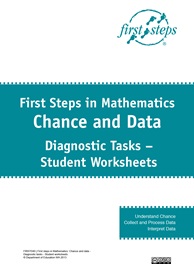As a result of their learning, students should be able to use their understanding of likelihood to compare and order everyday chance events, and be able to answer questions using data collection and/or interpretation.
- learn to recognise unpredictability in familiar daily activities and refine their use of the language of chance
- describe and order events from least to most likely
- begin to quantify ‘how likely’ it is that something will happen.
They should also begin to develop the understanding and skills needed to clarify the questions they want answered, and collect and handle data to help answer those questions. They should also consider such questions as ‘What kind of data?’ and ‘How much do we need so we can feel reasonably confident in our conclusions?’ The uncertainty involved in drawing conclusions from data is what connects ‘chance’ and ‘data’. Thus, learning experiences should be provided that will enable students to understand chance, collect and organise data, summarise and represent data, and interpret data.
As a result of their learning experiences, students should be able to achieve the following outcomes.
Understand Chance
Understand and use the everyday language of chance and make statements about how likely it is that an event will occur based on experience, experiments and analysis.
Collect and Process Data
Plan and undertake data collections and organise, summarise
and represent data for effective and valid interpretation and communication. There are two parts to this outcome—Part A: Collect and Organise Data and Part B: Summarise and Represent Data—with a separate chapter for each.
Interpret Data
Locate, interpret, analyse and draw conclusions from data, taking into account data collection techniques and chance processes involved.


